AUDI A5 COUPE 2012 Owners Manual
Manufacturer: AUDI, Model Year: 2012, Model line: A5 COUPE, Model: AUDI A5 COUPE 2012Pages: 316, PDF Size: 78.59 MB
Page 281 of 316

Tires with unidirectional tread design
Tires with unidirectional tread design must be
mounted with their tread pattern pointed in
the right direction.
Using a spare tire with a tread pattern
intended for use in a specific direction
When using a spare tire w ith a tread pattern
in tended for use in a specific direction, please
note the following:
- The direction of rotation is marked by an
ar
row on the side of the tire .
-If the spare t ire has to be installed in the in
correct direction, use the spare tire only
temporarily since the tire will not be able to
achieve its optimum performance character
istic s with rega rd to aquaplaning, noise and
wear.
- We recommend that you pay particular at
tention to this fact during wet weather and
that you adjust your speed to match road
conditions.
- Replace the flat tire with a new one and
have it installed on your veh icle as soon as
possib le to restore the handling advantages
of a unid irectiona l tire .
Notes on wheel changing
Please read the information c:> page 263, New
tires and replacing tires and wheels
i f you are
going to use a spare t ire which is different
from the tires on your veh icle.
After you change a tire :
-Check the tire pressure on the spare imme
diately after installation .
- Have the wheel bolt tightening torque
checked with a torque wrench as soon as
possible by your authorized Audi dealer or
a qualified workshop.
- With steel and alloy wheel rims, the wheel
bolts are correctly tightened at a torque of
90 ft lbs . (120 Nm).
- If you notice that the wheel bolts are cor
roded and difficult to turn while changing
a tire, they should be replaced before you
check the tightening torque. What do I do now? 2 79
- Replace the flat tire with a new one and
have it installed on your vehicle as soon as
possible. Remount the wheel cover.
Until then , drive with extra care and at re
duced speeds.
A WARNING
-
- If you are going to equ ip your vehicle
with tires or rims which differ from those
which were factory installed, then be
sure to read the information
c:> page 263,
New tires and replacing tires and
wheels.
- Always make sure the damaged wheel or
even a flat tire and the jack and tool kit
are properly secured in the luggage com
pa rtment and are not loose in the pas
senger compartment.
- In an accident or sudden maneuver they
could fly forward, injuring anyone in the
veh icle.
- Always store damaged wheel, jack and
tools securely in the luggage compa rt
ment. Otherwise, in an accident or su d
den maneuver they could fly forward,
causing injury to passengers in the vehi
cle.
([) Note
Do not use commercially available tire
sea lants. Otherwise, the electrica l compo
nents of the tire pressure monitoring sys
tem* wi ll no longer work properly and the
sensor for the tire pressure monitoring
system* will have to be replaced by a
qualified workshop . •
•
Page 282 of 316
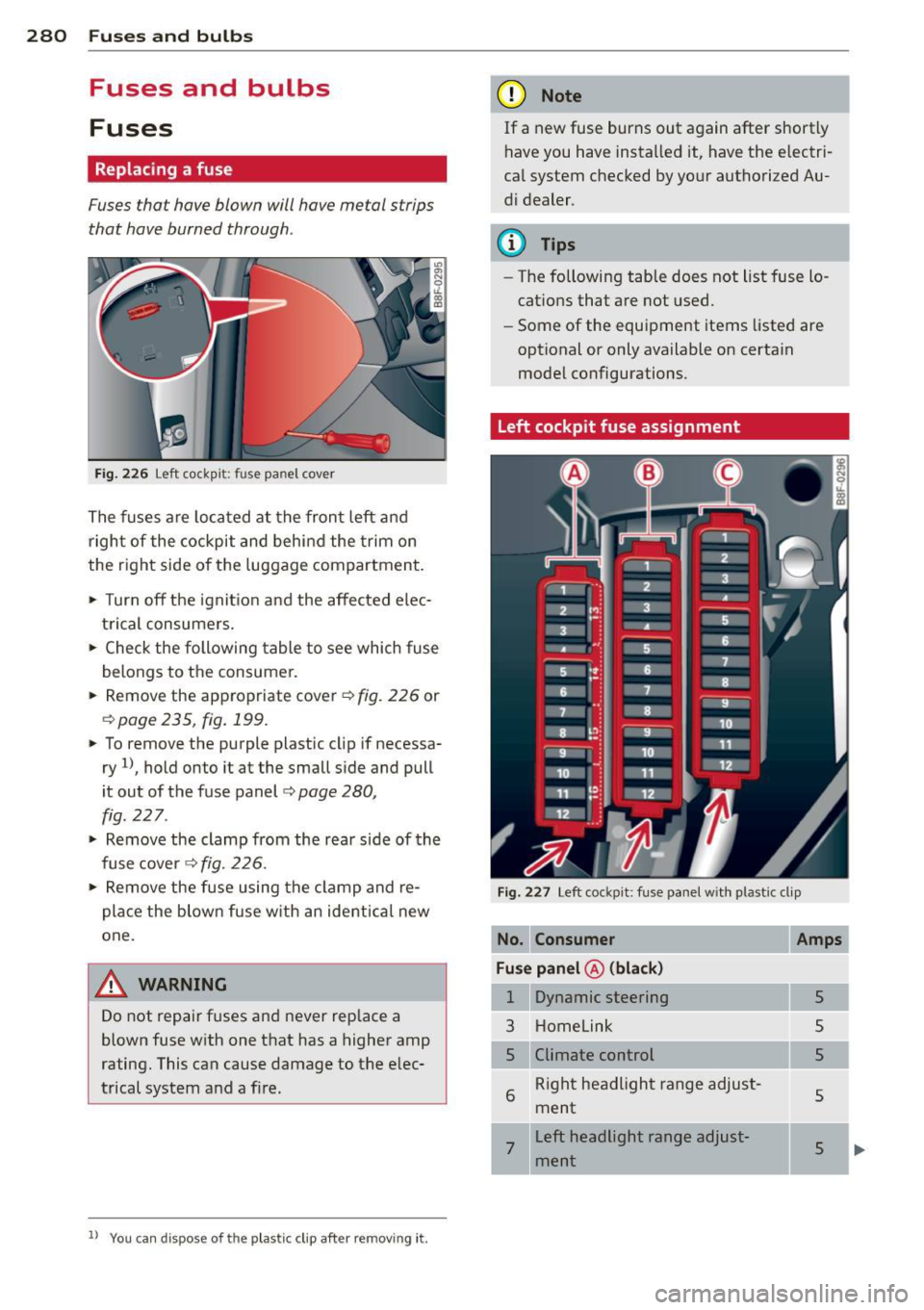
280 Fuses and bulbs
Fuses and bulbs
Fuses
Replacing a fuse
Fuses that have blown will have metal strips
that have burned through.
Fig. 226 Left cockpit: fuse panel cover
The fuses are located at the front left and
right of the cockpit and behind the trim on
the right side of the luggage compartment.
• Turn off the ignit ion and the affected elec
trical consumers.
• Check the following table to see which fuse
belongs to the consumer.
• Remov e the appropriate cover¢
fig. 226 or
¢ page 235, fig. 199.
• To remove the purple plastic cl ip if necessa
ry
1l, hold onto it at the small side and pull
it out of the fuse panel
c:> page 280,
fig. 227.
• Remove the clamp from the rear side of the
fuse cover ¢
fig. 226.
• Remove the fuse using the clamp and re
place the blown fuse w ith an ident ical new
one.
A WARNING
Do not repair fuses and never replace a
blown fuse with one that has a higher amp
rating. This can cause damage to the elec
trical system and a fire.
ll You ca n dispose of the p lastic clip afte r remov ing it.
(D Note
If a new fuse burns out again after shortly
have you have installed it, have the electri
cal system checked by your authorized Au
d i dealer .
(D Tips
-The following table does not list fuse lo
cations that are not used.
- Some of the equipment items listed are
optional or only available on certain
model configurations.
Left cockpit fuse assignment
Fig . 227 Left cockpi t: fu se pane l with plastic clip
No. Consumer
Fuse panel @(black)
1 Dynamic steering
3 Homelink
5
6
Climate control Right headlight range adjust
ment
Amps
5
5
5
5
7
Left headlight range adjust
ment
5 ...
•
Page 283 of 316

Fuses and bulbs 281
No. Fuse Location, Instrument Panel right
8
Vehicle electrical system control
5
module 1
9 Adaptive Cruise Control
10 Shift gate
11 Heater washer flu id nozzles
12 Climate control
13 Cell phone prep 5
14 Airbag
s
15 Terminal 15 25
16 Terminal 15 engine
40
Fuse panel@ (brown)
1 Automatic dimming
interior s rearview mirror
2 Clutch sensor 5
3 Gasoline fuel pump 25
5 Left seat heating with/without
15/30
seat heating
Fig. 228 Righ t cockpi t: fuse panel wi th pla stic clip
6 Electronic Stabilization Program 10 No. Consumer
7 Horn 25 Fuse panel@ (black)
8
Left door window regulator mo-
30
tor 5
Steering column switch module
5
6 Electronic Stabilization Program 5
9 Wiper motor 30
10 Electronic Stabilization Program
25
7
Terminal 15 diagnostic connec-
5
tor
11 Left doors 15
12 Rain and light sensor 5
8
Gateway (Databus diagnostic in-
5
terface)
Fuse panel © (red)
Fuse panel@ (brown)
3 lumbar support
10
1 C0-/DVD player
5
4 Dynamic steering 35
2 Audi drive select switch module 5
5 Antenna (Avant)
5
3 MMI/Radio
5/20
6
Vehicle electrical system control
35
module
1
7
Vehicle electrical system control
20
module 1 Instrument cluster
5
5 Gateway (instrument cluster
5
control module)
6 Ignition lock 5
8
Vehicle electrical system control
30
module 1
9 sunroof 20
10 Vehicle electrical system control
30
module 1
7 Rotary light switch 5
8 Climate control system blower
40
9 Steering column lock 5
10 Climate control 10
11 sunroof shade (Avant) 20 11 Terminal 30
diagnostic connec-
tor 10
12 Convenience electronics
5
12 Steering column switch module
5
Page 284 of 316
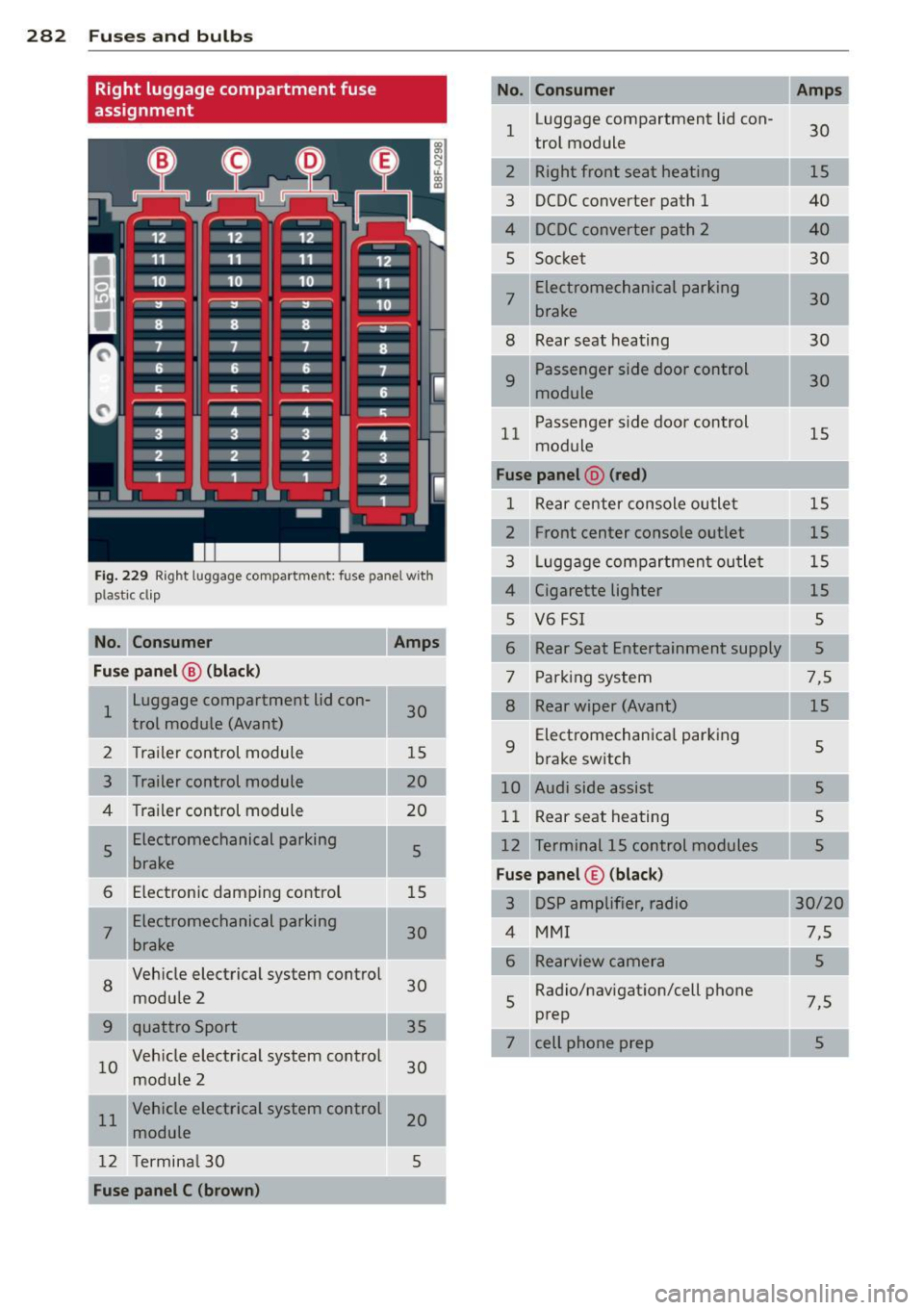
282 Fuses and bulbs
Right luggage compartment fuse
assignment
Fig. 229 Rig ht luggag e compar tmen t: fus e pan el w ith
pla stic cl ip
No. Consumer
Amps
Fuse panel @ (black)
1 Luggage compartment lid con-
30
trol module (Avant)
2 Trailer control module 15
3 Trailer control module
20
4 Trailer control module 20
I 5 Electromechanical parking
5
brake
6 Electronic damping control
15
7 Electromechanical
parking
30
brake
8
Vehicle electrical system control
30
module 2
35
10 Vehicle electrical system control
30
module 2
11 Vehicle electrical system control
20
module
12 Terminal 30 5
Fuse panel C (brown) No. Consumer
1
Luggage compartment lid con-
30
trol module
2 Right front seat heating
3 DCDC converter path 1
4 DCDC converter path 2
5 Socke t
7 Electromechanical parking
30
brake
8 Rear seat heating 30
9
Passenger side door control
30
module
11 Passenger
side door control
15
module
Fuse panel @ (red)
1 Rear center console outlet 15
2 Front center console outlet 15
3 Luggage compartment outlet 15
4 Cigarette lighter
15
5 V6 FSI 5
6 Rear Seat Entertainment supply
5
7 Parking
system 7,5
8 Rear wiper (Avant) 15
9
Electromechanical parking
5
brake switch
10 Audi side assist 5
11 Rear seat heating
5
Terminal 15 control modules
Fuse panel© (black)
3 DSP amplifier, radio
MMI
Rearview camera
5 Radio/navigation/cell
phone
prep 7,5
7 cell phone prep
5
Page 285 of 316
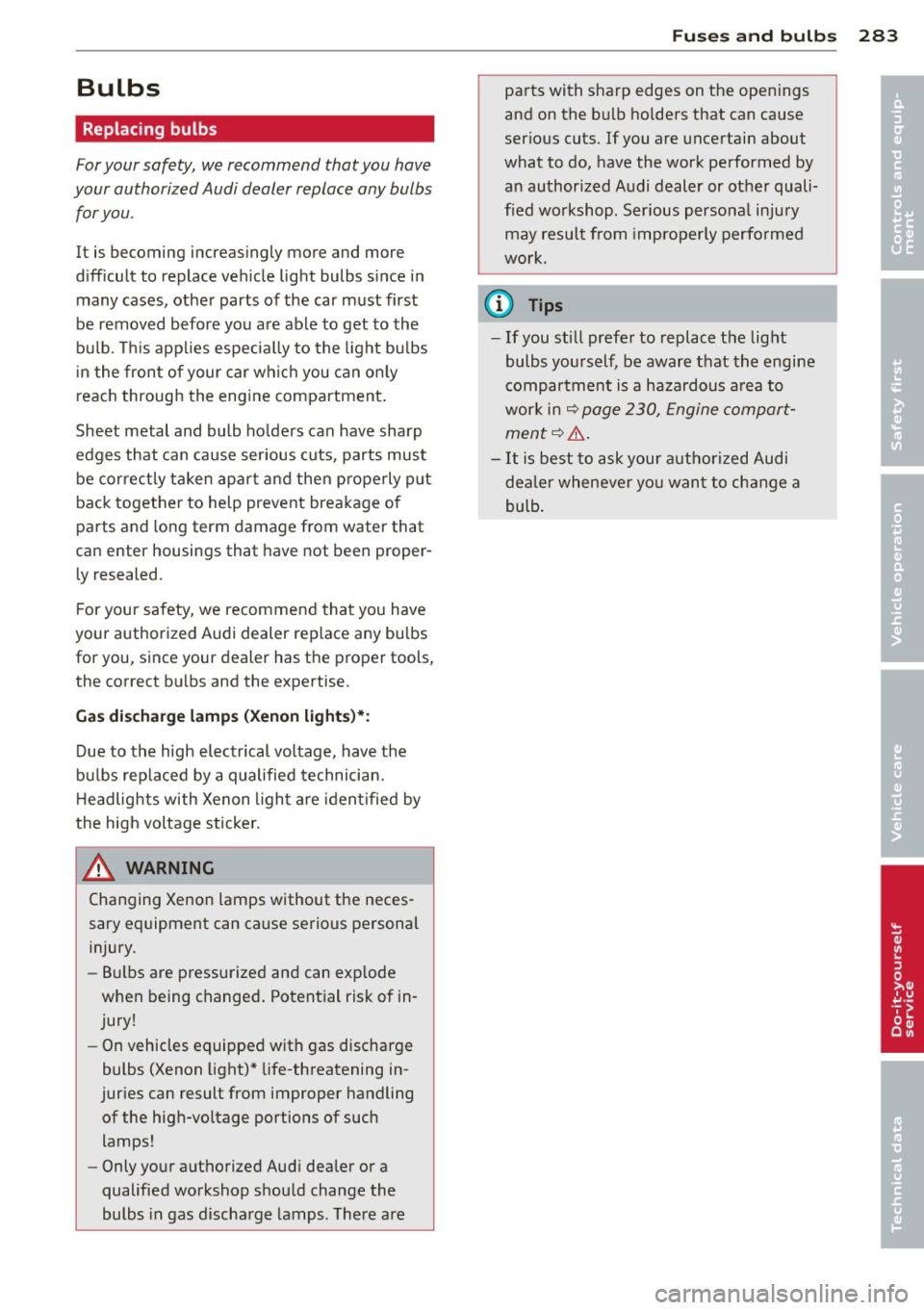
Bulbs
Replacing bulbs
For your safety, we recommend that you have
your authorized Audi dealer replace any bulbs
for you .
It is becoming increasingly more and more
difficult to replace vehicle light bulbs since in
many cases, other parts of the car must first
be removed before you are able to get to the
bu lb . T his appl ies especially to the light bu lbs
in the front of your car which you can on ly
reach through the engine compartment .
Sheet metal and bulb ho lders can have sharp
edges that can cause ser ious cuts, parts must
be correctly taken apart and then p roperly put
back together to help prevent breakage of
parts and long term damage from water that
can enter housings that have not been proper
l y resealed.
F or your safety, we recommend that you have
your authorized Audi dealer replace any bulbs
for you, since your dealer has the proper tools,
the correct bu lbs and the expertise.
G as disch arge la mp s (Xe no n li ght s)*:
Due to the high electrical vo ltage, have the
bu lbs rep laced by a qualified technician.
H eadlights with Xenon l ight a re identified by
the high voltage sticker.
& WARNING
Changing Xenon lamps without the neces
sary equipment can cause serious personal
injury.
- Bul bs are pressurized and can exp lode
when being changed . Potential risk of in
jury!
- On vehicles equipped with gas discharge
bulbs (Xenon light) * life-threatening in
jur ies can result from improper handling
of the high-voltage portions of such
lamps!
- Only your authorized Aud i dea ler or a
qualified workshop should change the
bulbs in gas discharge lamps. There a re
Fu ses and bulb s 28 3
parts with sharp edges on the open ings
and on the bulb holders that can cause
serious cuts. If you are uncertain about
what to do, have the work performed by
an author ized Audi dealer or other quali
fied workshop . Ser ious personal injury
may result from improperly perfo rmed
wo rk.
(j) Tips
- If you still prefer to replace the light
bulbs yourself , be aware that the engine
compartment is a hazardous area to
work in
c::> page 230, Engine compart
ment
o=:> ,& .
-It is best to ask your authorized Audi
dealer whenever yo u want to change a
bulb .
•
•
Page 286 of 316

284 Emergency situations
Emergency situations
General
This chapter is intended for trained emer
gency crews and working personnel who
have the necessary tools and equipment to perform these operations.
Starting by pushing or
towing
Q;) Note
Vehicles with an automatic transmission
cannot be started by pushing or towing.
Starting with jumper
cables
If necessary , the engine can be started by
connecting it to the battery of another vehi
cle.
If the engine should fail to start because of a
discharged or weak battery, the battery can be
connected to the battery of
another vehicle,
using a
pair of jumper cables to start the en
gine .
Jumper cables
Use only jumper cables of sufficiently
large cross section to carry the starter current
safely. Refer to the manufacturer's specifica
ti ons.
Use only jumper cables with
insulated termi
nal clamps which are distinctly marked :
plus(+) cable in most cases colored red
minus (-) cable
in most cases colored black .
A WARNING
Batteries contain electricity, acid, and gas.
Any of these can cause very serious or fatal
injury. Follow the instructions below for
safe handling of your vehicle's battery.
- Always shield your eyes and avoid lean
ing over the battery whenever possible. -
A discharged battery can freeze at tem
peratures just below
32 °F (0 °(). Before
connecting a jumper cable, you must
thaw the frozen battery completely, oth
erwise it could explode.
- Do not allow battery acid to contact eyes
or skin . Flush any contacted area with
water immediately .
- Improper use of a booster battery to
start a vehicle may cause an explosion.
- Vehicle batteries generate explosive gas
es . Keep sparks, flame and lighted ciga
rettes away from batteries .
- Do not try to jump start any vehicle with
a low acid level in the battery .
- The voltage of the booster battery must
also have a 12-Volt rating. The capacity
(Ah) of the booster battery should not be
lower than that of the discharged bat
tery . Use of batteries of different voltage
or substantially different "Ah" rating
may cause an explosion and personal in
jury.
- Never charge a frozen battery. Gas trap
ped in the ice may cause an explosion.
- Never charge or use a battery that has
been frozen. The battery case may have
be weakened.
- Use of batteries of different voltage or
substantially different capacity (Ah) rat
ing may cause an explosion and injury.
The capacity (Ah) of the booster battery
should not be lower than that of the dis
charged battery.
- Before you check anything in the engine
compartment, always read and heed all
WARNINGS¢
page 230, Engine com
partment.
@ Note
- Applying a higher voltage booster bat
tery will cause expensive damage to sen
sitive electronic components, such as
control units, relays, radio, etc.
- There must be no electrical contact be
tween the vehicles as otherwise current
could already start to flow as soon as the
positive(+) terminals are connected. ..,.
Page 287 of 316

@ Tips
-The discharged battery must be properly
connected to the vehicle's electrical sys
tem. When jump start ing or charging the
battery, never connect the negative
ground cable to the battery negative
post because the battery manager sys
tem must be able to detect the battery's
state of cha rge . A lways connect the neg
ative g round cab le to the negative
gro und post o f the battery manage r con
trol uni t.
Use of jumper cables
Make sure to connect the jumper cobl e
clomps in exactly the order describ ed b elow!
Fig. 230 Engine co mpartmen t: Con ne ctors fo r jum per
c ables a nd char ger
Fi g. 231 Jump s tart in g w ith t he ba ttery of a not her ve
hi cle :@ booster battery, @ disc harged vehicle bat tery
The procedure described below for connecting
jumper cables is intended to provide a jump
start for your veh icle .
Vehicle with discharged batter y:
.. Turn off lights and accessories , move lever
of automatic transmission to
N (Neutral) or
P (Park) and set parking brake.
Emergenc y situ ation s 285
Connect POSI TIVE(+ ) to POSITIVE (+ )
(red )
.. Remove the cover above the jump start con
nection .
.. Open the red cover on the positive pole
¢fig. 230 .
1. Connect one end of the red positive cable
on the
jump sta rt bolt ¢ fig. 231 (D
(Bolts under red cover= "positive ") of the
vehicle to be star ted @.
2. Connect the othe r end to the pos itive ter -
mina l@ of the booster battery @.
Connect NEGATIVE (-) to NEGATIVE (-)
(black )
3. Connect one end of the b lack negative ca
ble to the nega tive te rmi na l@ of the
booster battery @.
4 . Connect the other end to the
jump start
bolt @
(Bolts with hex head = "negative")
of the vehicle to be started @.
Sta rting the engine
.. Start t he engine of the veh icle w ith the
booster battery @. Run the engine at a
moderate speed .
.. Start engine w ith d ischarged vehicle battery
® in the usual manner .
.. If the eng ine fails to start: do not keep the
starter crank ing for lo nger than 10 seconds .
Wait for about 30 seconds and the n try
aga in .
.,. With engi ne runni ng , remove j umper cab les
from both vehicles in the exact
reverse o r
der .
.. Close the red cover on the positive pole .
T he battery is vented to the o utside to p revent
gases from entering the veh icle in ter ior . Make
s ur e that the j umper clamps a re well connect
e d with their
metal ports in full contact with
the batte ry terminals.
A WARNING
To avoid serious personal injury and dam
age to the vehicle, heed all warnings and
instructions of the jumper cable manufac-
turer . If i n doubt, call for road service .
Ill>
Page 288 of 316
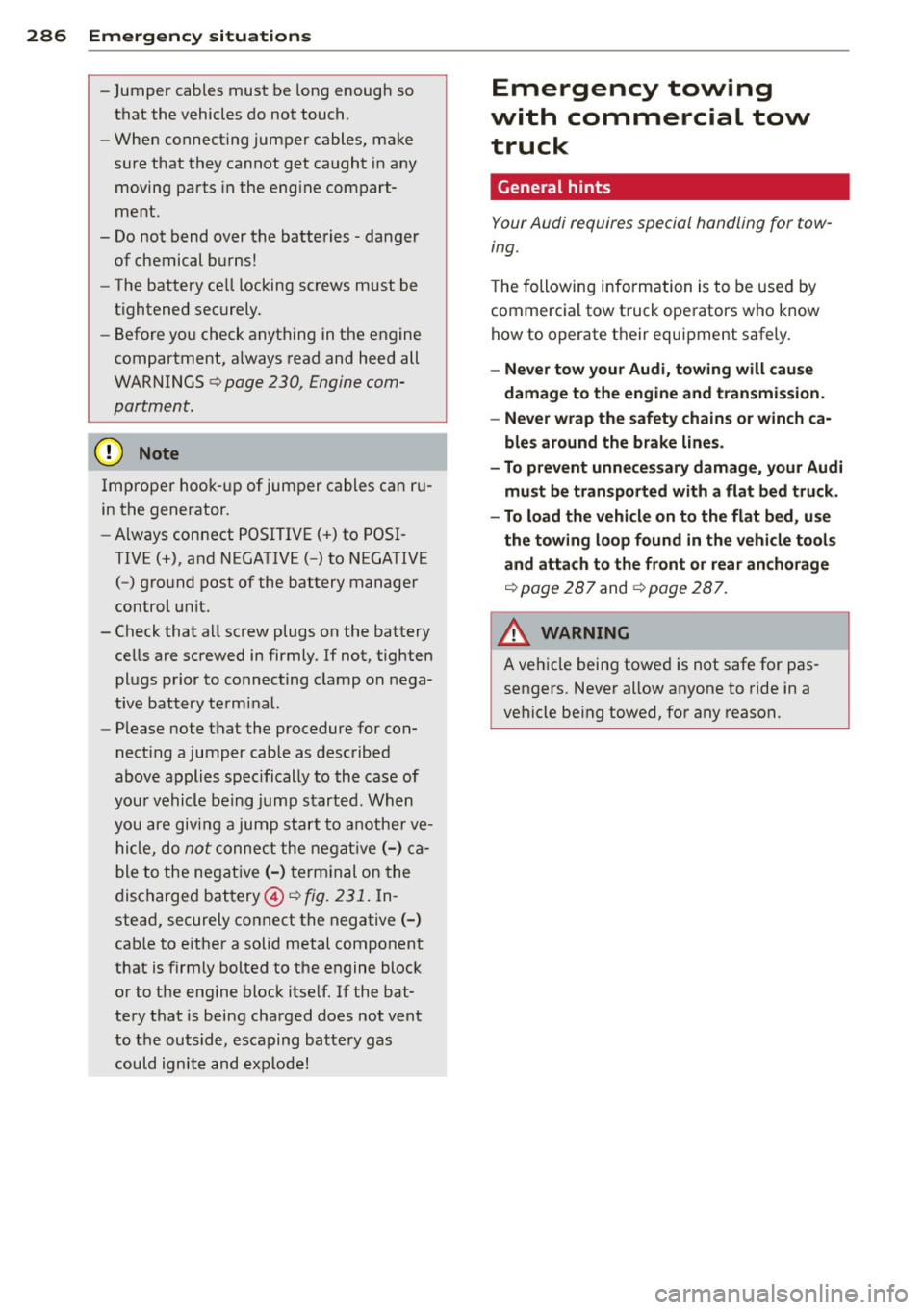
28 6 Em ergency sit uat ions
-Jumper cables must be long enough so
that the vehicles do not touch.
- When connecting jumper cables, make
sure that they cannot get caught in any
moving parts in the engine compart
ment.
- Do not bend over the batteries -danger
of chemical burns!
- The battery ce ll locking screws must be
tightened securely .
- Before you check anything in the engine
compartment, always read and heed all
WARNINGS 9
page 230, Engine com
partment.
(D Note
Improper hook-up of jumper cables can ru
in the generator.
- Always connect POSITIVE( +) to POSI
TIVE(+), and N EGATIVE( -) to NEGATIVE
( - ) ground post of the battery manager
control unit.
- Check that all screw plugs on the battery cells are sc rewed in firmly . If not, tighten
plugs prior to connecting clamp on nega
tive battery terminal.
- Please note that the procedure for con
nect ing a jumper cable as described
above applies spec ifically to the case of
your vehicle being jump started . When
you are giving a jump start to another ve hicle, do
not connect the negat ive (-) ca
ble to the negative( -) terminal on the
discharged battery@9fig.
231. In
stead, securely connect the negative(-)
cab le to either a solid metal component
that is firmly bolted to the engine block
or to the engine block itse lf. If the bat
tery that is being charged does not vent
to the outside, escaping batte ry gas
could ignite and explode!
Emergency towing
with commercial tow
truck
General hints
Your Audi requires special handling for tow
ing.
T he following information is to be used by
commercial tow truck operators who know
how to operate their equipment safely.
- Nev er tow y our Audi , tow in g will cau se
damage t o the engi ne and tr an smi ssion .
- Ne ver wrap th e safety chain s or winch ca
bl es around the b rak e lin es.
- To pre vent unne ce ss ary dam age, your Audi
mus t be tr an sp o rt ed with a flat bed t ruck.
- To load th e vehicle on to th e flat b ed, use
th e t owing l oop found in th e vehicle too ls
a nd a ttac h to th e front or rea r a nchor age
c;,poge 287 and c;,page 287 .
& WARNING
= -
A vehicle being towed is not safe for pas
sengers. Never allow anyone to ride in a
vehicle being towed, for any reason.
Page 289 of 316
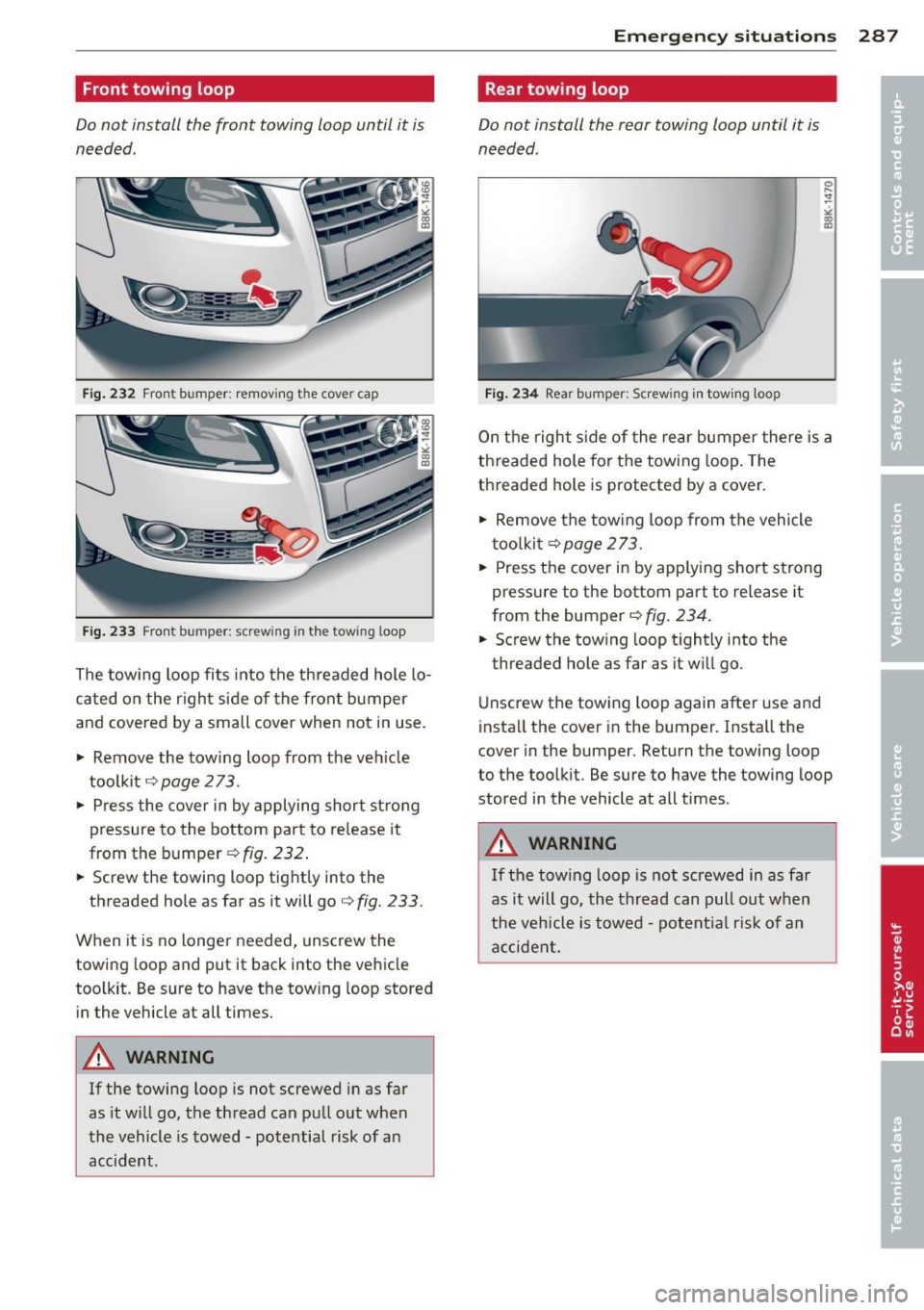
Front towing loop
Do not install the front towing loop until it is
needed.
Fig. 232 Fro nt bumper : removing t he cover cap
Fi g. 233 Front bumper: screw ing in t he tow ing loop
The tow ing loop fits into the th readed hole lo
cated on the r igh t side of the fron t bumper
and covered by a small cover when not in use .
"' Remove the towing loop from the veh icle
toolkit
c:::> page 2 73 .
"' Press the cover in by applying short st rong
pressure to the bottom part to re lease it
from the bumper
c:::> fig. 232 .
"' Screw the towing loop tight ly into the
threaded hole as far as it will go
c:::> fig. 233 .
When it is no longer needed, unscrew the
towing loop and put it back into the vehicle
too lkit. Be sure to have the tow ing loop stored
in the vehicle at all times.
A WARNING
If the towing loop is not screwed in as far
as it w ill go, the thread can pull out when
the vehicle is towed - potential risk of an
acc ident.
Emergenc y situ ation s 287
Rear towing loop
Do not install the rear towing loop until it is
needed .
Fig . 23 4 Rea r bumper: Screw ing in tow ing loop
On the right s ide of the rear bumper there is a
th readed hole for the towing loop . The
threaded hole is protected by a cover .
"' Remove the tow ing loop from the vehicle
t oo lkit
c:::> page 2 73.
"' Press the cover in by app lying short strong
pressure to the bottom part to release it
from the bumper
c:::> fig. 234.
"' Screw the tow ing loop tightly into the
threaded hole as far as it w ill go.
Unscrew the towing loop again after use and
insta ll the cover in the bumper. Install the
cover in the bumper. Return the towing loop
to the toolkit. Be sure to have the towing loop
stored in the vehicle at all times .
A WARNING
If the towing loop is not screwed in as far
as it will go, the thread can pull out when
the veh icle is towed -potent ia l risk o f an
accident.
Page 290 of 316
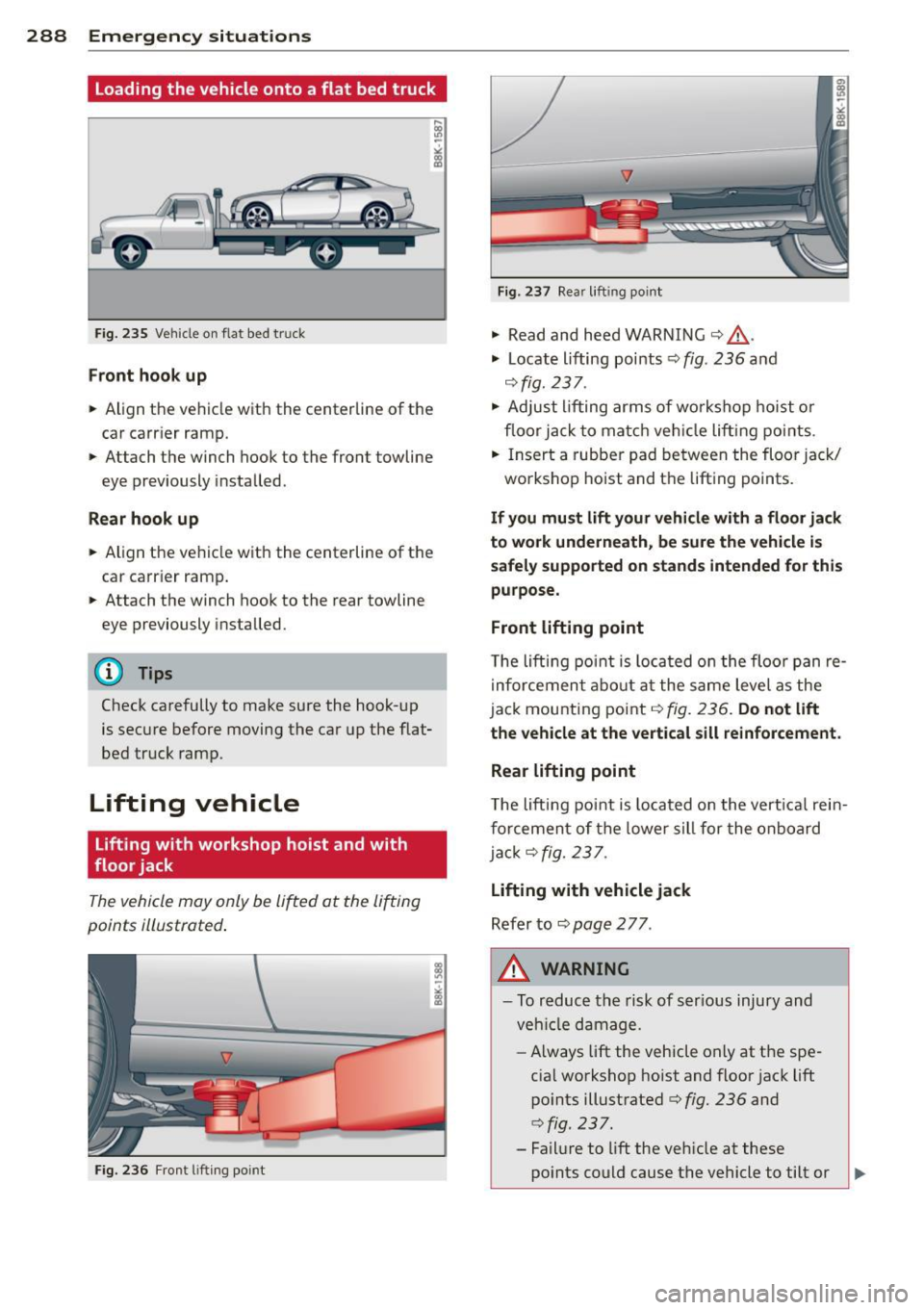
288 Emergency situations
loading the vehicle onto a flat bed truck
Fig . 235 Vehi cle on flat bed t ruck
Front hook up
,,. Align the ve hicle with the centerline of the
car carr ier ramp.
,,. Attach the winch hook to the front towline
eye previously insta lled .
Rear hook up
,,. Align the vehicle with the centerline of the
car ca rrier ramp .
,,. Attach the winch hook to the rear towline
eye previously installed.
{!) Tips
Check carefully to make sure the hook- up
is secure be fore moving the car up the flat
bed truck ramp.
Lifting vehicle
lifting with workshop hoist and with
floor jack
The vehicle may only be li~ed at the lifting
points illustrated .
Fig . 2 36 Front lift ing po int
Fig. 237 Rea r liftin g po int
,,. Read and heed WARNING r=;, .&, .
,,. Locate lifting poi nts r=;, fig . 236 a nd
r=;, fig. 237 .
,,. Adjust lifting arms of wo rks hop ho ist o r
floor ja ck to ma tc h veh icle lift ing poi nts .
,,. Insert a rubber pad be tween the floo r jac k/
workshop hoist and t he lift ing points.
If you mu st lift your vehi cle with a floor jack
to work underneath, be sure the vehicle is
safely supported on stand s intended for this
purpose.
Front lifting point
T he lift ing po in t is loca ted o n the floo r pan re
i nforcemen t abo ut a t the same leve l as the
jack mounting point
r=;, fig. 236. Do not lift
the vehicle at the vertical sill reinforcement .
Rear lifting point
T he lifti ng poi nt is located o n the vert ic al rei n
f o rcemen t of the lower s il l for the onboard
jac k
r=;, fig. 23 7.
lifting with vehicle jack
Refer to c:> page 2 77 .
A WARNING
---To r educe the risk of ser ious injury and
veh icle damage.
- Always lift the vehicle only at the spe
cia l workshop hoist and floor jac k lift
po ints illustrated
r=;, fig. 236 and
r=;, fig. 237 .
- Failure t o lift the vehicle at these
po ints could cause the vehicle to tilt or ,...